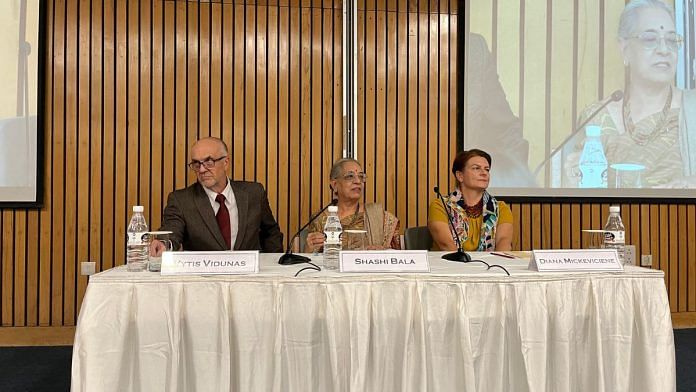New Delhi: Sanskrit has a rich history and literature but it also has a global family. Now Sanskrit and the Lithuanian language want to know more about their relationship status.
“The Lithuanian language is the closest living sister language to Sanskrit,” said Lithuania’s Ambassador to India Diana Mickeviciene during a recent lecture series organised by the Ministry of External Affairs and the Embassy of Lithuania. The series is focused on the similarities between the two languages. “It is a well-known living fact in Lithuania and Europe.”
Sanskrit’s ties to the German language are well-documented but the new Lithuanian connection was so intriguing that the lecture hall was packed with over 70 people.
The lecture, chaired by Professor Shashi Bala, Dean of Bharatiya Vidya Bhavan’s KM Munshi Centre for Indology, was the 12th in a series titled Kriti-SAMHiTA: The Plurality of Indian Knowledge Systems.
“It opens people’s hearts when you realise how closely your languages are connected despite thousands of kilometers of distance between our countries. Several Lithuanian scholars reached out to India to learn about this, to study it,” said Mickeviciene.
Also read: Stop making Gujaratis your punching bag. Find another way to attack Modi
Building on shared vocabulary
To strengthen cultural and linguistic ties between India and Lithuania, Sanskrit scholar Vytis Vidunas of Lithuania and Mickeviciene have embarked on a mission to look into historical linguistic ties between Sanskrit and Lithuanian. Vidunas is widely published in Vedic literature. He has given lectures at many universities including University College, Thiruvananthapuram. He collated a dictionary of 108 words that sound and mean the same in Sanskrit and Lithuanian. He collected materials for a decade before he decided to publish it.
And currently, he is planning another dictionary, which is going to be bigger than the last one. Vidunas has big plans for it. These days, he is traveling to Pune, Kolkata and other cities to encourage young Indian scholars to collaborate with him on the dictionary.
“I published a few years ago, a small dictionary of 108 words which directly correspond to early Sanskrit and Lithuanian. But it’s not all the vocabulary we could expose and show, and therefore we need to proceed with our works. I hope this is a good beginning today for our common work,” said Vidunas
Vidunas expounded the similarities between Sanskrit and Lithuanian and gave a few examples. God is called Dievas in the Lithuanian language and Devas in Sanskrit. Honey is called medus in Lithuanian and madhu in Sanskrit.
“For a larger dictionary, I will need some Indian scholar to come on board with me. We have just started this project and we will see how it will go,” said Vidunas.
Mickeviciene talked about the intellectuals who travelled to India to explore the language. “My own hero Antanas Poska travelled to India on a motorbike in 1929, despite the fact that there were barely any roads in Europe to India. But Sanskrit was his dream and motive so he came and studied here for six years,” said Mickeviciene.
Vidunas mentioned another historian who explored this connection—Dionizas Poska.
In 1826, Poska, a famous Lithuanian Humanitarian, in his letter to Joachim Lelewel, a Polish historian and professor at Vilnius University, presupposed that “Sanskrit could be the father and mother of all the languages”.
Also read: Sanskrit texts show Medieval Indians loved foreign goods, luxury. Not just temples
Horses and act of worship
Not only words but some phrases are also common in both languages. ‘Devo dantan adadad devo dhanam dasyati’ is a phrase in Sanskrit. It means that God gave teeth, the god will give bread. ‘Dievas dantis dave, dievas duona duo’ is its Lithuanian version.
Vidunas claimed that the German scholar Peter Bohlen was possibly the first to use such comparisons.
In Lithuania, little horses are common motifs. They are called asplenia, which originated from ashwa, the Sanskrit word for horses.
Bala built on the significance of the history surrounding horses in Lithuanian and Indian cultures. “Horses are protectors because they represent power and speed that was used in wars and they also represent knowledge. All the Sanskrit texts were taken on horseback,” Bala said.
The lecture showed that India and Lithuania are geographically distant, but when it comes to their culture, language, and ways of thinking, they are very close.
The practice of worship was one of the many similarities found during the lecture.
“Our civilisation developed on the banks of the rivers. Because the river flows with pure water and whatever around trees, fruits. So, the river culture also brings us together and also agni (fire). They (Lithuanians) are also worshipers of agni,” said Bala.
Much needs to be done to fully explore the relationship between Sanskrit and its Lithuanian sister.
“The first idea is to increase awareness about this, but the second motive is to call out for more cooperation, to research this connection more because it’s been under-researched and I think it will be very interesting to both Indian and Lithuanian scholars,” Mickeviciene said.
(Edited by Ratan Priya)



